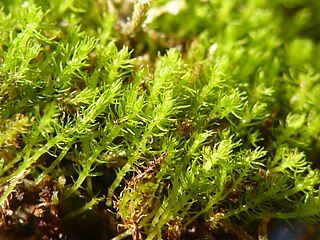
Takakia is a genus of two species of mosses known from western North America and central and eastern Asia. The genus is placed as a separate family, order and class among the mosses. It has had a history of uncertain placement, but the discovery of sporophytes clearly of the moss-type firmly supports placement with the mosses.
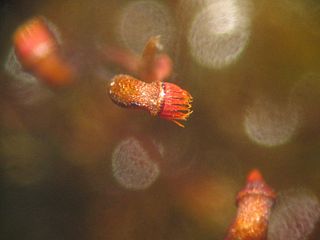
The Bryopsida constitute the largest class of mosses, containing 95% of all moss species. It consists of approximately 11,500 species, common throughout the whole world.
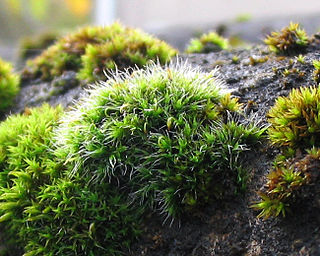
Grimmiales is an order of mosses in the subclass Dicranidae. It comprises four families: Grimmiaceae, Ptychomitriaceae, Seligeriaceae, and Saelaniaceae.

Sphagnopsida is a class of mosses that includes a single subclass Sphagnidae, with two orders. It is estimated it originated about 465 million years ago, along with Takakia. The order Sphagnales contains four living genera: Ambuchanania, Eosphagnum, and Flatbergium, which counts four species in total, and Sphagnum which contains the rest of the species. The extinct Protosphagnales contains a single fossil species.

Acritodon is a genus of moss in the family Hypnaceae. It is a monotypic genus only containing the species Acritodon nephophilusAcritodon nephophilus is endemic to Mexico, where it is known only from two locations in the Sierra Madre de Oaxaca of Oaxaca state. Its natural habitat is subtropical or tropical moist lowland forests. It is threatened by habitat loss. Conservation efforts for this species have difficulty protecting local populations due to insufficient attention and legislation regarding preservation of moss species.

Pottiales is an order of mosses in the subclass Dicranidae.

Andreaeobryum is a genus of moss with a single species Andreaeobryum macrosporum, endemic to Alaska and western Canada. The genus is placed as a separate family, order and class among the mosses.
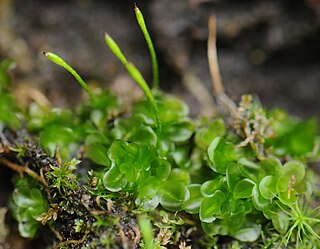
Oedipodium is the only genus of moss in the family Oedipodiaceae. It contains the single species Oedipodium griffithianum, the gouty-moss or Griffith's oedipodium moss. This species is distributed in cooler climates of Eurasia, as well as from Alaska, Washington state, British Columbia, Yukon, Greenland, Newfoundland, Tierra del Fuego and the Falkland Islands.
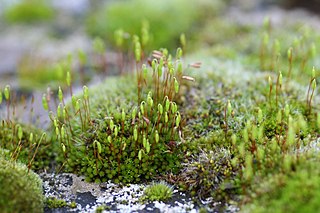
Bryales is an order of mosses.

Encalyptales is an order of mosses in subclass Funariidae. It contains a single family.
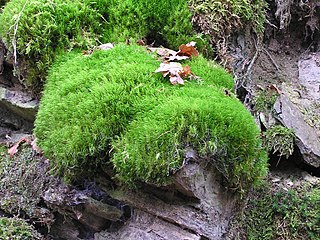
Dicranales is an order of haplolepideous mosses in the subclass Dicranidae.

Fissidentaceae is a family of haplolepideous mosses (Dicranidae) in the order Dicranales, with a single genus, Fissidens. It was formerly placed in the now-obsolete order Fissidentales.
Eustichia is the only genus of moss in family Eustichiaceae. The family was previously place in the order Dicranales, but is now placed in its own monotypic order, Eustichiales.
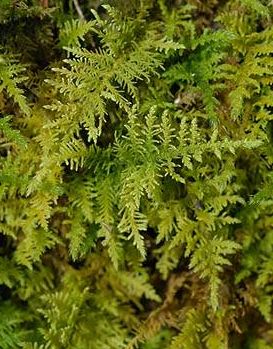
Hypnales is the botanical name of an order of Bryophyta or leafy mosses. This group is sometimes called feather mosses, referring to their freely branched stems. The order includes more than 40 families and more than 4,000 species, making them the largest order of mosses.

Ptilium is a genus of mosses with very broad worldwide occurrence. This genus is within the family Hypnaceae, in the class Bryopsida, subclass Bryidae and order Hypnales.
Vesicularia dubyana, known as Java moss or Singapore moss, is a species of moss native to Asia. It is common in the aquarium trade.
Pseudoditrichum is a rare North American genus of haplolepideous moss (Dicranidae). It is the only known genus in its family (Pseudoditrichaceae), and there is only one species in the genus. Pseudoditrichum mirabile has been found only in a small area along the Sloan River near Great Bear Lake. This is in the Northwest Territory in northern Canada, only a few kilometers south of the Arctic Circle.
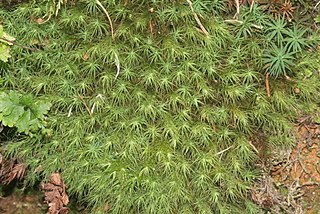
Bartramiales is an order of moss.

Taxiphyllum is a genus of mosses in the family Hypnaceae.
William Russel Buck is an American bryologist.
















